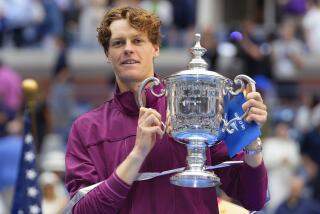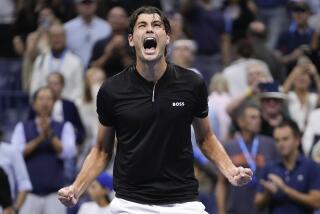U.S. OPEN TENNIS : Lendl Breaks Down Agassi, Will Face Becker in Final
- Share via
NEW YORK — Ivan Lendl and Boris Becker, the top-ranked players in tennis, will meet today for the U.S. Open men’s championship and perhaps decide who’s No. 1 for 1989.
The 109th U.S. Open, the fourth and final Grand Slam event this year, promises to be a clash of superpowers between Australian Open champion Lendl and Wimbledon champion Becker.
It is a battle for tennis supremacy between two privileged members of its ruling class, a contest neither Andre Agassi nor Aaron Krickstein could prevent.
The No. 1-ranked Lendl tied Bill Tilden’s record of reaching eight consecutive U.S. Open finals when he defeated Agassi Saturday in a four-set semifinal, 7-6 (7-4), 6-1, 3-6, 6-1.
Becker’s path to the final was through Krickstein, whom he discarded in straight sets, 6-4, 6-3, 6-4.
The first German to reach the U.S. Open final since Baron Gottfried von Cramm lost to Don Budge in 1937, the No. 2-ranked Becker has won each of the three matches he has played against Lendl in the past two years, including a five-set victory in the semifinals at Wimbledon exactly two months ago.
Lendl said Becker’s winning streak is irrelevant.
“Three is an unlucky number, so let’s just go for one now,” Lendl said. “The past doesn’t mean a thing. You start zero-zero and everybody is equal.”
At this year’s Open, no one has been the equal of either Lendl or Becker. On a warm and muggy day, Krickstein tried first.
The 22-year-old baseliner from Michigan thought his only chance was to make Becker go the distance. Krickstein wanted five sets but got only three.
After gaining an early service break in the first set, Krickstein gave it right back, and his headband just got tighter and tighter.
“I never got any momentum going,” Krickstein said.
Precisely, Becker said. The big points, he said, belong only to him.
“Every human being is different,” Becker said. “Some prefer when there are important points to play and others prefer 40-love.
“I prefer when it is break point down.”
For Krickstein, such occasions were extremely rare, even though Becker once again found it difficult to get his first serves in.
Lendl’s problem, in the second semifinal, was to figure out a way to make it difficult for Agassi, and the method he chose was to get ahead, two sets to none. Lendl did it the hard way.
Agassi, who also lost to Lendl in last year’s Open semifinals, staked himself to first-set leads of 4-1 and 5-2, but then he swooned.
Two unforced forehand errors and a booming Lendl forehand winner put Agassi into an 0-40 hole. He scrambled to 30-40 but then gave Lendl a break back when he unloaded another big forehand that landed wide.
Lendl seemed to be expecting them.
“He goes for a lot of shots and sometimes he makes them and sometimes he doesn’t,” Lendl said.
“He just starts hitting harder and harder, and of course it can’t go in all the time,” Lendl said.
Forced into a tiebreaker to decide the set, which had once seemed so clearly his own, Agassi could only watch helplessly as Lendl produced the most important shot of the set.
Lendl found the deepest corner of the court with a powerful backhand winner down the line for a 5-3 lead in the tiebreaker. Then, at 5-4, Lendl served an ace to give himself a set point, which he cashed in when Agassi’s topspin forehand from the baseline flew long.
Lendl was off and running to start the second set. He served a love game, broke Agassi at 30 and held serve again at love. After a first set of 1 hour 14 minutes, Lendl held a second-set lead of 3-0 and had allowed Agassi only five points.
Struggling to stay in the set at 1-5, Agassi lost his serve at love and knew he was in deep trouble.
“After that first set, he got that early game, and then it was just tough to stop him,” Agassi said. “I think if I had taken advantage of him in the first set, it could have been a real interesting match out there.”
Agassi’s flagging interest in the match found a boost in the fourth set, but Lendl was playing more like someone trying to conserve his energy than someone who seemed vulnerable.
So Agassi went quickly in the fourth set, finished off by a single service break.
“He fell off,” Lendl said. “That was probably partly physical and partly mental.”
Becker, 21, is the youngest male player to reach the U.S. Open final since John McEnroe in 1980. McEnroe, who was 2 1/2 months younger, defeated Bjorn Borg on that occasion in a five-set epic that included two tiebreakers.
Since the Open era began in 1968, only three other players have won Wimbledon and the U.S. Open in the same year. Becker could be the fourth. The others are McEnroe (1981 and 1984), Jimmy Connors (1974 and 1982) and Rod Laver (1969).
The matchups: Lendl is 58-4 for the year and Becker 51-6. Lendl has won seven tournaments this year and Becker three.
Except for his quarterfinal match against Yannick Noah, Becker has surprised many by his ability to be successful staying back and hitting groundstrokes, which is vastly different than his normal serve-and-volley style.
Lendl has not varied his approach. He continues to show a preference to engage in slugfests, punching shots from the baseline and wearing down whoever is on the other side of the net.
Becker, meanwhile, admits that he has not played as well as he can these two weeks. “I’ll tell you what, it’s not how good or how bad you play, it comes down to if you win or if you lose,” Becker said. “If you are in a semifinal or final of a Grand Slam, it has not much to do with tennis, it has to do with keeping your nerves under control.”
Said Lendl: “We will see.”
Said Becker: “Just see what happens.”
As for who’s really No. 1, well, seeing is believing.
More to Read
Go beyond the scoreboard
Get the latest on L.A.'s teams in the daily Sports Report newsletter.
You may occasionally receive promotional content from the Los Angeles Times.










